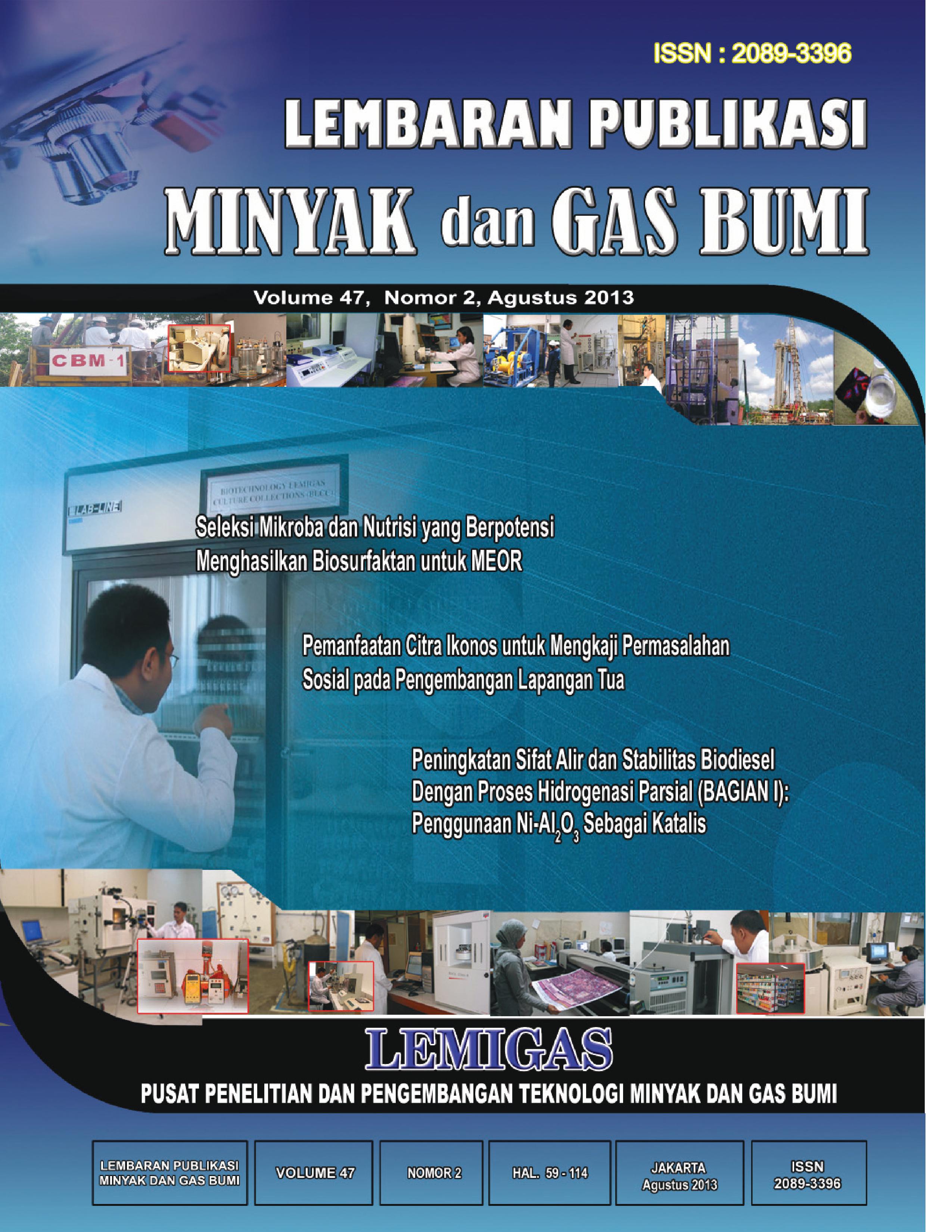Manfaat Surfaktan dari Bakteri Laut Hidrokarbonoklastik untuk Akselerator Proses Hidrokarbon Minyak Bumi
DOI:
https://doi.org/10.29017/LPMGB.47.2.241Kata Kunci:
biosurfaktan bakteri laut hidrokarbonoklastik, akselerasi biodegradasi crude oilAbstrak
Pencemaran yang disebabkan oleh tumpahan minyak bumi telah banyak terjadi di perairan darat maupun laut. Berbagai upaya telah dilakukan salah satunya yaitu penambahan senyawa surfaktan sintetik ke perairan. Pemakaian surfaktan sintetik ternyata akan menjadi limbah yang menyebabkan kerusakan lingkungan, sehingga diperlukan upaya untuk menanggulanginya. Penelitian ini bertujuan untuk mengetahui potensi bakteri laut hidrokarbonoklastik (Halobacillus trueperi dan Rhodobacteraceae bacterium) dalam memproduksi biosurfaktan. Penelitian dibagi menjadi 5 perlakuan, yaitu kontrol (Media+Minyak Bumi dan Media+Minyak Jelantah), Media+Minyak Bumi+Halobacillus trueperi, Media+Minyak Bumi+Rhodobacteraceae bacterium, Media+Minyak Jelantah+Halobacillus trueperi dan Media+ Minyak Jelantah+Rhodobacteraceae bacterium. Parameter pengukuran meliputi diameter zona bening (uji bakteri penghasil biosurfaktan) bobot biomasa, bobot endapan asam, dan tegangan permukaan (produksi biosurfaktan). Hasil penelitian menunjukkan R. bacterium dengan sumber karbon minyak jelantah lebih berpotensi memproduksi biosurfaktan dibandingkan dengan bakteri H. truperi. Produksi biosurfaktan yang dihasilkan oleh bakteri R. bacterium sebesar 0,7047 g/L. Isolat bakteri R. bacterium dapat menurunkan tegangan permukaan dari 40,80 mN/m hingga mencapai 30,09 mN/m, kemampuan menurunkan hingga 30,09 mN/m sehingga biosurfaktan yang di produksi bakteri ini dapat digunakan sebagai akselerator biodegradasi hidrokarbon pencemaran minyak bumi di laut.
Referensi
Bica F.C., L.C. Fleck and M.A. Zachio. 1999. Production of Biosurfactant by Hydrocarbon Degrading Rhodococcus rubber and Rhodococcus erythropolis. J. Microbiol, 30: 231-236.
Christova, N., Ivshina, I.B. 2002. Microbial Surfactants and Their Use in Field Studies of Soil Remediation. J. Applied Microbiol., 93: 915-929.
Dehghan, G., Behravan, dan Moshafi. 2008. Studies on Biosurfactants Production by Bacillus licheniformis Iran. Pharmaceutics Research Center, Kerman University of Medical Sciences.
Desai, JD., Banat, IM. 1997. Microbial Production of Surfactants and Their Comersial Potential. Microbiology and Molecular Biology Review, 61: 47-64.
Hidayati , N. V., Endang, H., Abdul, H., Hefni, E., Michel, G., Pierre, D., Agung D. S. 2011. Fluorene Removal by Biosurfactants Producing Bacillus megaterium. Waste and Biomass Valorization. 2: 415- 422.
Kadarwati, S., Leni, H. 2008. Effect Of Biosurfactant Produced By Bacillus In Oily Wastewater Degradation. Lemigas Research and Development Centre for Oil and Gas Technology. 31 (3) : 40-41.
Kasai, Y., Kishira, H., Syutsubo, K., Harayama, S. 2001. Molecular detection of Marine Bacterial Popullations on Beaches Contaminated by The Nakhodka Tanker Oil-spill Accident. Environ Microbiol, 3: 46-55.
KimS,LimE,LeeS,LeeJ,danLeeT. 2000. Purification and Characterization of Biosurfactants from Nocardia sp. L-417. Biotechnology and Applied Biochemistry 31: 249-253.
Kosaric, N. 1992. Biosurfactants in Industry. Pure and Appl. Chem, 64: 1731-1737.
Mishra, M., Muthuprasanna, Surya, Sobhita, Satish, Sarath, G.Arunachalam and Shalini. 2009. Basics and Potential Applications of Surfactants-A Review. International Journal of PharmTech Research. 1: 1354-1365.
Morikawa, Hirata Y, Imanaka T. 2000. A Study On The Structure Function Relationship Of The Lipopeptide Biosurfactants. Biochim Biophys Acta. 1488: 211-218.
Mulligan, C.N. and Bernard F. Gibbs. 2004. Types, Productiont Applications of Biosurfactants. Proc. Indian Natn Sci Acad. 1; 31-55.
Ni’matuzahroh, Arif Y., dan Mulyadi, T. 2006. Studi Perbandingan Biosurfaktan pseudomonas aeruginosa Ia7d dan Surfaktan Sintetik tween-80 dalam Biodegradasi Solar oleh Mikroba Perairan Pelabuhan Tanjung Perak Surabaya. Berk. Penel. Hayati: 12:13-18.
Nitschke, M. and Pastore, G. M., 2002. Biosurfactans:Properties and Applications. Quim. Nova; 25; 772-776.
Nugroho, Astri. 2006. Bioremediasi Hidrokarbon Minyak Bumi. Graha Ilmu Yogyakarta. Yogyakarta. 158 hal.
Prastikasari, R. 2000. Pengaruh Hidrokarbon Sebagai Sumber Karbon Terhadap Pertumbuhan, Produksi Rhamnolipid serta Aktivitas Degradasi Hidrokarbon Oleh Pseudomonas aeruginosa. Skripsi. Fakultas Teknologi Pertanian, Institut Pertanian Bogor, Bogor.
Schramm, L. L, Elaine N. S. and Gerrard M. 2000. Surfactants and Their Applications. Annu. Rep. Prog. Chem., Sect. C. 99: 3-48.
Sineriz, F., Hommel, K.R., Kleber, P.H. 2010. Production of Biosurfactants. Biotechnology, 5.
Syakti, A.D. 2004. Biotransformation des hydrocarbures pétroliers et effets sur les acides gras phospholipidiques des bactéries hidrocarbonoclastes marines. Thése-Doctorat. Université Paul Cezzanne Aix Marseille III. 220p.
Syakti AD., Hidayati, N.V,. Yani, M., Sidiana, I.M. 2008. PAH-Degaders Marine Bacteria Isolated From Chronically Contamined Sediment by Petroleum Hydrocarbons. Seminar Nasional Perhimpunan Mikrobiologi Indonesia (PERMI).
Techaoei S., P., Lumyong, S., Prathumpai, W., Santiarwan, D., Leelapornpisid, P. 2011. Screening Characterization and Stability of Biosurfactant Produced by Pseudomonas aeruginosa SCMU106 Isolated From Soil in Northern Thailand. Asian Journal of Biological Sciences, 4 (4): 340-351.
Vater J, Kablitz B, Wilde C, Franke P, Mehta N, and Cameotra SS. 2002. Matrix assisted Laser Desorption Ionization-time of Flihgt Mass Spectrometry of Lipopeptide biosurfactant in Whole Cell and Culture Filtrates of Bacillus subtilis C-1 Isolated from Petroleum Slude. J. Appl. Environ. Microbiol 68: 6210-6219.











